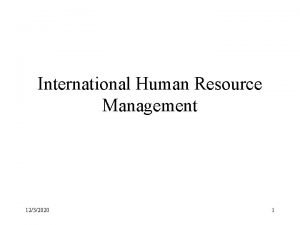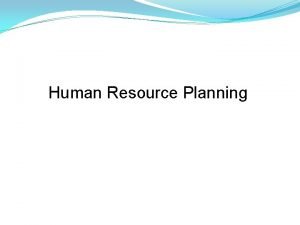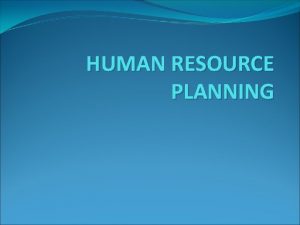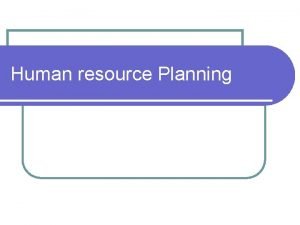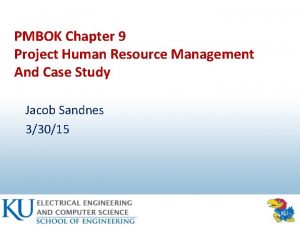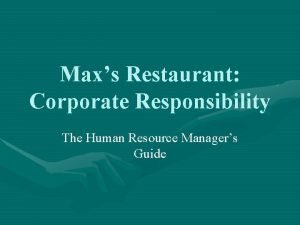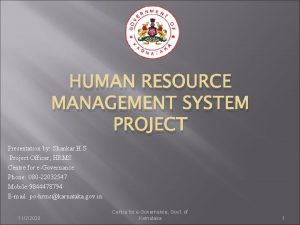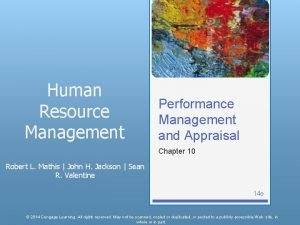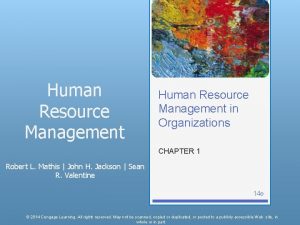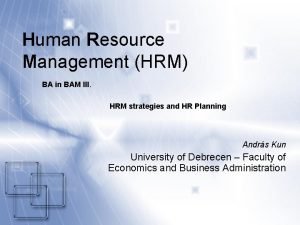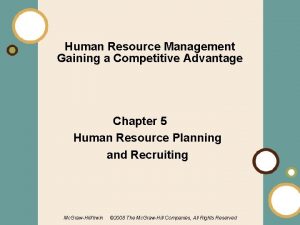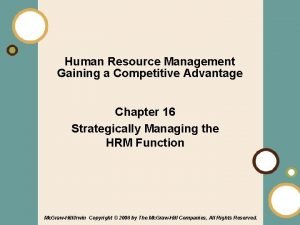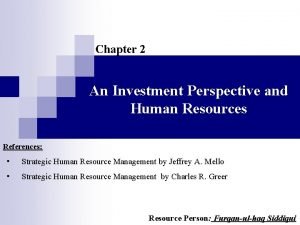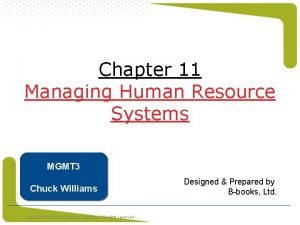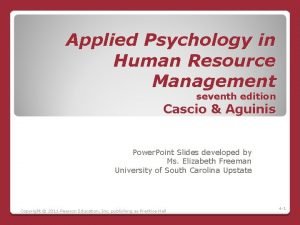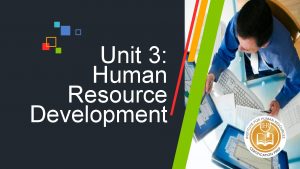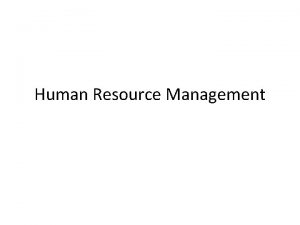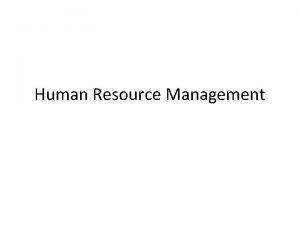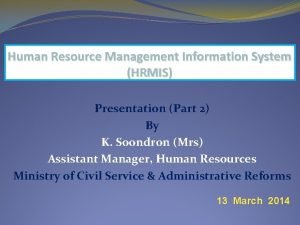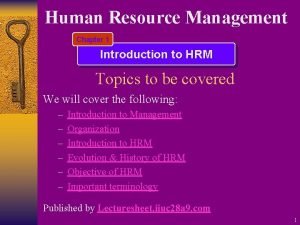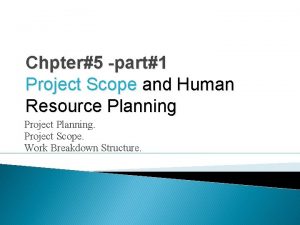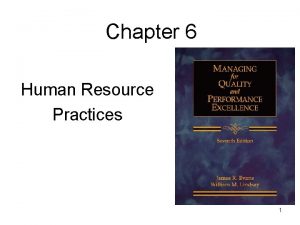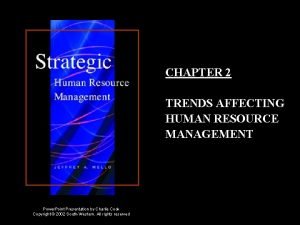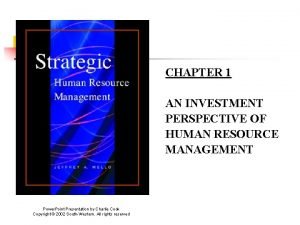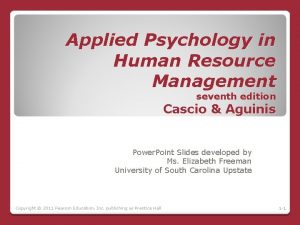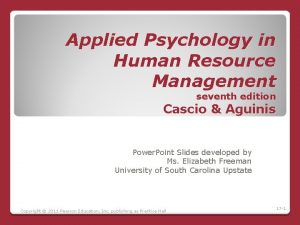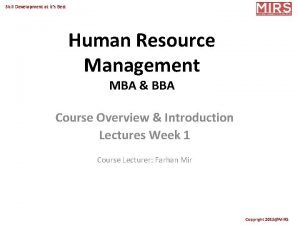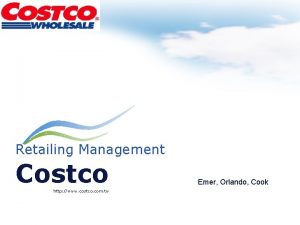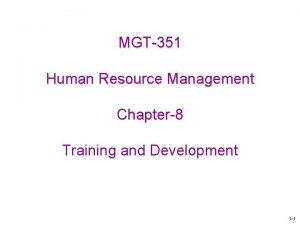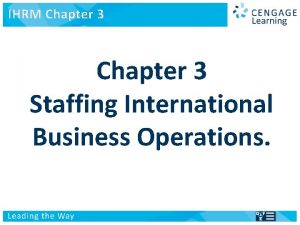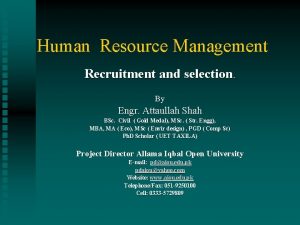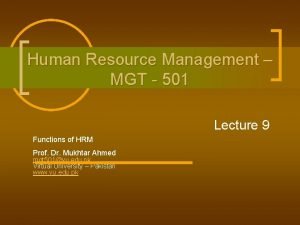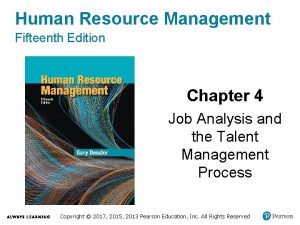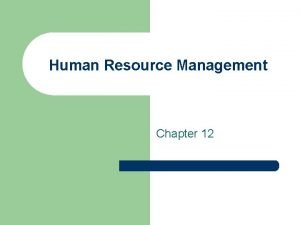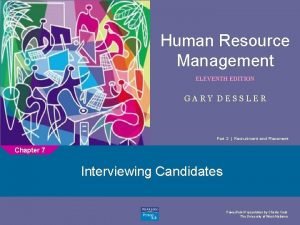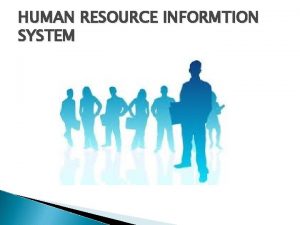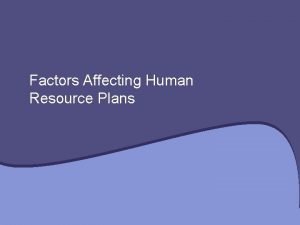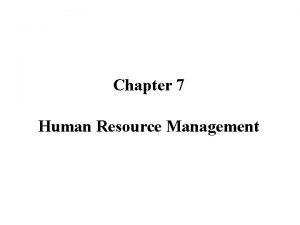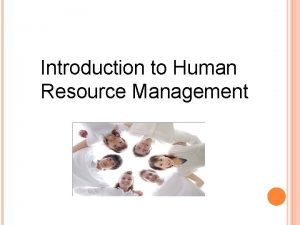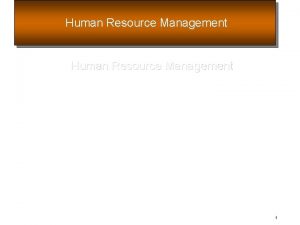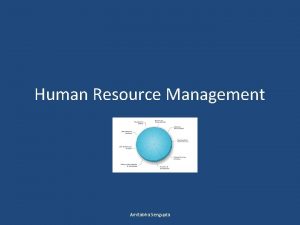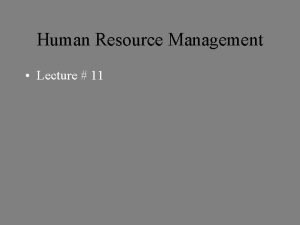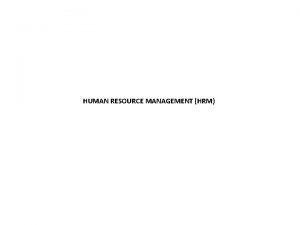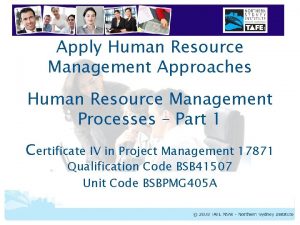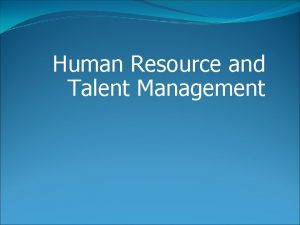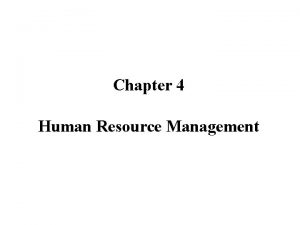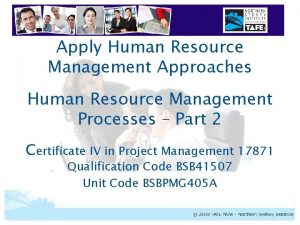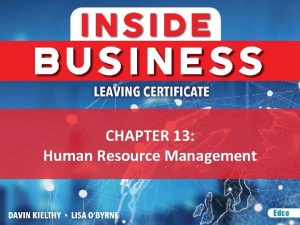Human Resource Management Meaning Human resource is of
































































- Slides: 64

Human Resource Management

Meaning: Human resource is of paramount importance for the success of any organization. Human resource is the total knowledge, abilities, skills, talents and aptitudes of an organization’s work force. Human Resource Management: HRM is the function within an organization that focuses on recruitment of, management of and providing direction for the people who work in the organization. It is also an organization function that deals with the issues related with people such as: compensation, performance management, organization development, employee motivation and training.

Features of HRM: • It is confined to managing people at work in an organization. • The development of individuals and satisfaction of their goals is in the ambit of HRM. • The management functions such as planning, organizing, directing, coordinating and control are applicable to staff management. • The attending to staffing functions such as recruitment, placement, selection etc. is a part of HRM.

Nature of HRM: • • • Part of process of Management Comprehensive function People Oriented Based on Human Relations Pervasive Function Continuous process Science as well as Art Recent origin Interdisciplinary

Essentials of HRM: • Employees enjoy their work. • Employees have a sense of accomplishment in and through their work. • Employees have a high sense of belonging to their organization and workplace. • Employees feel that they are respected as individuals and their contributions are values • Employees have a feeling to enhance their competence and perform more challenging and satisfying task.

Need for HRM approach : • • • For better industrial relations Develop organizational commitment Coping with changing environment Change in political philosophy Increased pressure on employees

Objectives Of Human Resource Management Organisational Objectives Functional Objective Personal Objective Societal Objective

Organisational Objectives ü It should aim to serve the interests of the organisation. üIt should focus on achieving goals of the organisation. üIt should work to bring organisational effectiveness. Functional Objectives üIt aims at recruit and train Suitable manpower for the organization. üThe level of service of employees should be tailored to suit the needs of the organisation. üIt should be judiciously used for achieving organisational goals.

Personal Objective üThe working environment should be created to improve the efficiency. üEmployees should be motivated to contribution maximum to the 4 organisation. üEfforts should be made to increase job satisfaction of the employees. üThe employees should be personally informed about their personal policies of the organisation. Societal Objective üManage human resource in an ethical and socially responsible manner. üVarious legal and ethical standards are complie with.

HRM Vs HUMAN RESOURCE Development Human resource management and human resource development are used interchangeably. These are two different terms. HRM HRD 1. HRM is a wider term. 1. HRD is a narrow term. 2. It helps in developing skills, talents, capabilities, potentials of people in the organization. 2. HRD strategy is to bring about the changes in personnel so that new challenges are met. It is mainly related with development of individual employee in accordance with the aspirations and potentials on the one hand the company’s requirement on the other hand.

SCOPE OF HUMAN RESOURCE MANAGEMENT üIdentifying & developing persons HRM helps in spotting right persons for right jobs. Persons are assigned as per their aptitude persons are given right type of training so that they are able to develop their potential to the maximum. HRM helps in doing so. üRetaining Suitable Persons Modernization of various techniques, computerization of data processing , introduction of micro-process controlled machines have resulted in demand for trained and highly skilled persons. HRM not only helps in procuring suitable persons but is also useful in retaining them.

üCreating work Culture The aims and priorities of individual workers are given due weightage in the schemes of the organization. Human resource policy is backed by the human values, understanding and concern for the welfare of people the work culture in the organization improves, people feel satisfied and enjoy their work. üEducating Managerial Personnel HRM approach will succeed only when managerial personnel change their attitude towards work force. . There is a need to educate executives, managers and top management regarding various aspects of the human resources approach adopte 3 d in the organization. üConducting Research The framing of human resource policies, strategies and approaches depend upon the information collected through research. üDeveloping a Communication System HRM develops a system of communication where policies of the management are properly communicated to the lowest level of hierarchy and feed levels is conveyed to the top management. for e. g. upward and downward channel of communication.

Limitations of human resource management üRecent origin HRM is recent origin. It lacks universally approved academic base. Some organisation have named their personnel management departments as human resource management. üLack of Top management Support HRM must have the support of top level management. The change in attitude at the top can bring good results while implementing HRM. Because of passive attitude at the top, this work is handled by personnel management people. üImproper Implementation Human resource management should be implemented by assessing the training and developing needs of the employees the needs and aspirations of the people should be taken in to account while framing the human resource policies. Management’s productivity and profitability approach remains undisturbed in many organizations.

üInadequate Information Some organizations do not have requisite information about their employees. The needs and aspirations of the employees. In the absence of adequate Information And database this system cannot be properly implemented there is need to collect, store information before implementing human resource management.

Significance of HRM Crucial Role in Development Process Proper Use of Resource

Crucial Role in Development Process HRM plays a very crucial in the economic development of a country. Many countries have not been developed inspite of the availability of natural resources. The reason is that countries do not possesses entrepreneurs and motivated work force. According to Lewis, The quality of HRM is an important determinant of a country’s development. HRM helps in creating conductive work environment where employers and employees become partners in development. Proper Use of Resource The use of natural resources in a productive and economical way is the hands of those who use them. The wastage off natural resources is natural loss in an organisation. The growing competition in the market is forcing organizations to control cost and increase efficiency. It will mean that all the resources are used in

most economical way and the output is increased to the best possible levels. HRM helps in making better environment in the organization.

Evolution Of The Concept of HRM üLabour as a commodity Industrial revolution give rise to factory system. Earlier Guild system operated in the form of a group. It was closely knit group of workers where selection, training rewarding etc. Was done by the head of the group. The factory system should shifted from residence to factory. There was separation of ownership and management. The workers was considered as v commodity which cold be purchased like other commodities. üLabour as a tools for higher production The workers were taken as one of the factors of production. It was realized that proper trained workers helps in increasing productivity. The workers gained better status over the commodity concept. üPaternalistic Approach This approach was based in the belief that management must assume a fatherly and protective attitude towards employees. The management start taking interest I needs of the workers and

employees started organize themselves into trade unions. The govt. also recognize the fact that workers have a right to organize themselves for protecting their employment. The employer and employees should realize that they are depend upon each other. üHumanitarian Concept This concept was based in the belief that employees had certain rights as human beings and it was duty of the employers to protect these rights. It was realized that for increasing labour productivity all the needs of the workers have to be met. üHuman resource concept It was realized that organizational goals can be achieved by satisfying aspiration of employees. Both are complimentary and can be satisfied at the same time. Efforts are made to integrate employees with the organizational goals and employees aspiration could be achieved simultaneously. üEmerging Concept This concept is aims at creating a feeling among workers that the organization is their own managements should accept their workers as partners in their organization. This implies that workers should be offered better quality of working

life and proper opportunity to exploit their potential. The quality of workforce is influencing the performance of the whole organization

HRM AND PERSONNEL MANAGEMENT

HUMAN RESOURCE MANAGEMENT • Human Resource Management (HRM) is a process consisting of the acquisition , development, motivation and maintenance of human resources. • Human Resource Management is the organisational function that deals with issues related to people such as compensation, hiring, performance management, organisation development, safety, wellness, benefits, employee motivation, communication, administration and training.

PERSONNEL MANAGEMENT Personnel Management is an extension of general management, that of promoting and stimulating every employee to make his fullest contribution to the purpose of the business.

DIFFERENCE BASIS HUMAN RESOURCE MANAGEMENT PERSONNEL MANAGEMENT 1. OBJECT Concerned with development of skills and competencies of employees. Managing people at work. 2. TREATMENT Employees are treated as a resource and an asset. Employees are treated like other components such as machines, equipment, etc. 3. SIGNIFICANCE Employees are treated as economic, social and psychological men. Employees are taken as economic men. 4. IMPORTANCE Employees are treated as profit centre, amount invested in employees brings revenue. Employees are treated as cost centre. Payments of wages, salaries etc. are taken as cost of labour. 5. NEED Considered as strategic management function, essential for an organisation. Taken as a supplementary function or auxiliary function.

NATURE OF PERSONNEL MANAGEMENT MANAGING PEOPLE • Personnel managing is concerned with managing all types of people working in the organisation including clerical staff, executives and managers and everyone working in the enterprise. CONCERNED WITH EMPLOYEE • Personnel management deals with employees both as individuals and groups. Its aim is to obtain the best results from individuals. HELPING EMPLOYEES • Personnel development help employees to develop their talent by providing them opportunities. This will give them job satisfaction and improve their performance.

UNIVERSAL APPLICATION • Personnel Management is used everywhere and in every type of organization whether government, semi-government, non-profit organisation or industrial and commercial houses. CONTINUOUS APPLICATION • Personnel Management is continuously used in every type of situation. It requires a constant alertness and awareness of human relations and their in everyday of operations.

OBJECTIVES ENTERPRISE OBJECTIVES • The primary objective of personnel management is to help in achieving organisational objectives. • To achieve organisational goals there is need for proper co-operation for which the persons employed should be capable of taking up the jobs assigned to them. They should be given proper training for undertaking the work effectively. • This is possible by suitable policy of recruitment, training and placement. • The satisfaction of employees should be ensured to get their whole hearted cooperation. This is possible by looking after looking at their convenience at work and offering them financial and other incentives. • Employees should be motivated to contribute their maximum to the organisational goals

PERSONNEL OBJECTIVES SOCIAL OBJECTIVES • material and mental satisfaction to each employee in the organisation. • employees are provided with proper work environment and job satisfaction. • The work place should be neat, clean and properly ventilated. • Job satisfaction also includes good remuneration, job security, promotion, etc. • preserving and advancing general welfare of community. • serve the society in various ways for eg. by creating more and more employment opportunities. • producing quality goods at cheap goods and producing minimum waste.

FUNCTION OF PERSONNEL MANAGMENT A. MANAGEMENT FUNCTIONS B. OPERATIVE FUNCTIONS Planning Employment Organising Human resource development Directing Compensation Co-ordinating Human relation Controlling Maintenance

(A) MANAGERIAL FUNCTIONS: 1. PLANNING: Determining needs of persons Deciding the source of procuring them Determining training needs Selecting motivators Preparing job analysis, job description etc

2. ORGANISING: Organising is process of allocating the task among its members for achieving organizational goals. To achieve various policies and stratergies are decided upon. Organising is a channel for implementing them and achieving the organizational goals. It decides who should do what and who is responsible to whom!. Organisational structure should be designed in such a way that span of control, authority, relationship, communication channels are clear.

• 3. DIRECTING: Directing means telling people to do a particular task. It does not mean only issuing orders but also ensuring that the workers perform according to the standards set. The instructions set should be clear so that they are obeyed properly. Motivating employees to accomplish their task is included in this. The circumstances , psychology, economic , and social factors taken into consideration while selecting techniques of motivation.

4. CO-ORDINATING: Organisational objectives will be achieved only if group activities in the enterprise are co-ordinated effectively. Co-ordination of personnel is required at all levels of management. it co-ordinates task of developing , interpreting and reviewing personnel policies and programmes related to employees. The grievance redressal procedure is also planned for employee assistance. 5. CONTOLLING: Controlling is the act of checking , regulating and verifying whether everything is going as per the standards set and if variations exist taking corrective measures.

(B) OPERATIVE FUNCTIONS 1)EMPLOYMENT: Job analysis Human resource planning recruitment Selection placement Induction and orientation

(i) JOB ANALYSIS : It is detailed and systematic study of jobs to know the nature and characteristics of the people to be employed on various jobs. (ii) HUMAN RESOURCE PLANNING : ü Forecasting future manpower requirements. ü Making an inventory of present manpower resources. ü Anticipating manpower problems ü Planning programmes of recruitment, selection , training , development , compensation etc.

(iii) RECRUITMENT : Process of choosing duly qualified persons according to requirements of job. (iv) SELECTION : Process of choosing duly qualified persons according to the requirement of the jobs. (v)PLACEMENT : It involves the process of assigning the selected candidate with the most suitable job in terms of job requirement.

(vi)INDUCTION AND ORIENTATION : a) These are techniques by which a new employee is rehabilitated in the changed surroundings and introduced to the practices, policies , purposes and people etc. b)Introducing the employees to the people with whom he has to work. c)Mould the employee attitudes to the new environment.

2) HUMAN RESOURCE DEVELOPMENT Performance Appraisal Management Development Training (i) PERFORMANCE APPRAISAL Developing and establishing standard Communication of standards to employees Measuring actual performance Discussing reports with employees Taking corrective actions

(ii)TRAINING ü Identification of training needs ü Developing suitable training programmes. ü Advising the management in the conduct of training programmes. ü Imparting requisites skill and knowledge of employees Evaluating the effectiveness of training programmes. (iii)MANAGEMENT ü ü ü DEVELOPMENT Identifying the areas in which development is needed Conducting development programmes Motivating executives Designing special programmes for promotions Evaluating the effectiveness of development programmes.

3)COMPENSATION It is a process of providing adequate, equitable and fair remuneration to the employees. It includes job evaluation, wage administration and salary administration, incentives, bonus, fringe benefits, social security measures etc.

• 4. HUMAN RELATIONS Motivating the employees Boosting employee morale Developing the communication skills Redressing employee grievances properly and in time by means of a well-formulated grievance procedure. • Handling disciplinary cases. • Counselling the employees in solving their personal, family and work problems and releasing their stress. Strain and tensions. • Improving quality of work life of employees • • • 5. MAINTENANCE: T This function deals with sustaining and improving the working conditions. Health , sanitation and safety standards should b kept in mind.

ROLE OF A PERSONNEL MANAGER v. Advisory Role : provides advice to all departments regarding manpower planning , recruitment, selection , training , appraisal , compensation etc. v. Counselling Role : discusses various problems of employees with regard to their work, career, health , family , social etc and suggest ways to overcome these problems. v. Humanitarian approach : he should advice the management about the moral and ethical obligations towards the employees.

• Role of a change agent : he should be familiar with the needs and changing environment of business. He should work for improving personnel policies and introducing and implementing major institutional changes. • Acting as mediator : handle disputes b/w workers and management , superiors and subordinates etc • Legal hole role : helps in settlement of disputes , interpretation and implementation of various labour laws.

• WELFARE ROLE : he maintains canteens , creches, hospitals, libraries, consumer stores etc for welfare of employees. • ASSISTING LINE MANAGER : Personnel manager assists line managers in implementing various personnel policies in their respective departments. • HUMAN RELATION ROLE : He must improve performance of employees and increasing productivity by fulfilling economic , social , psychological needs of workforce.


HRM function is a staff function. Line managers view personnel officers as staff executives who prevent line managers from doing their job. Personnel managers are expected to advise, counsel and assist the managers, but with limited power and authority they cannot play diverse role expected from them.

Excessive Labour Laws Personnel department is required to implement various labour laws in the organisation. There is an excessive legalistic approach to labour problems. Personnel officers are required to attend to disputes and grievances of labour force.

Authoritarian Culture Indian businesses are generally controlled by family managements. The position of a person in management is determined by his family hierarchy rather than his personal qualifications and experience. Human resource is considered as cost and not as an asset. Personnel management is not treated as a creative activity and this type of attitude prevents its development.

Personnel function does not attract talented young persons because of : Unattractive salary structure Low status in the organisation Absence of job security and, Job satisfaction

Conflict with line managers Line managers are generally critical about the role of personnel managers in the organisation. Line managers feel that personnel managers do not own responsibility in case of failure and take credit if things happen favourably. This type of conflict creates mistrust among line and personnel managers.

Approach not fully developed • HRM approach is not fully developed in India this is mainly due to : • Cheap labour availability • Technological backwardness • Authoritarian culture • Traditional management systems.

Lack of professional attitude There is absence of professional attitude among the personnel people as required by the changing environment. The curriculum is outdated and inadequate to the needs of modern organisations.


With the emergence of multinational corporations , the size of workforce is increasing in the country. The increase in size of workforce passes number of problems and challenges for the human resource managers as the new workforce is conscious of its rights.

Changing composition of workforce Due to easy access to educational and employment opportunities, the scheduled castes , scheduled tribe and other minority groups are fast becoming important source of manpower in the organisations. The managers have to take in account the availability of talent in these groups. The increased number of married female employees and working mothers bring new problems before human resource managers.

Globlisation of business The emergence of globlisation has brought new challenges for the workforce. The new cultures, languages , working methods, educational levels, social factors have to be kept in mind while dealing with outsiders coming to home markets. Foreign companies try to make better use of skilled force in the host country and the personnel managers are expected to help in making an environment desired by new masters. HRM faces the challenges of improving productivity while keeping the workforce motivated and satisfied in the context of globlisation.

Social factors influence both the work force and the firm. The society is the consumer of the products of the firm. With the change in business scenario the society is becoming more and more demanding. A firm cannot survive if it does not satisfy social expectations. HRM prepares the workforce for responding to the needs of the society and creating a good impression of firm by providing good quality products at reasonable prices. Therefore social impacts have to be evaluated by HRM before preparing plans.

Technological changes The upgrading of technology changes the methods of work. Workers need training for handling new machinery. HRM is required to arrange proper training for the existing workforce. There may be a need to recruit fresh persons with specific qualification and technical background, it may also reduce the existing workforce.

Increase in education levels The increase in level of education has made the employees more mobile. Educational workers are more aware of their rights. Human resource managers have to develop appropriate policies and techniques to motivate the educated workers.

Changes in legal environment Many changes are taking place in the legal framework. It is the duty of the human resource managers to keep an eye on these changes and bring necessary adjustments within the organisation so that greater utilisation of human resources can be achieved.

PERSONNEL POLICY A policy is a general statement or a body of understanding which guides thinking and action in decision making. A personnel policy provides advanced information and predictable solutions which are repetitive and occur widely through out the organisation. It is the total commitment of the organisation to act in a particular way while dealing with its employees.

Characteristics of A Sound Personnel Policy • Should be clear, precise and easily understandable. • Should be in writing • Should protect the interest of all parties • Should be supplementary to overall objective of the organisation. • Should not be rigid • Must provide two-way communication • Should have support of all the concerned parties • Should be uniform throughout the organization

FACTORS INFLUENCING PERSONNEL POLICY Philosophy of management: Whether management is centralised or decentralised? ? How much delegation will be allowed? ? Role of subordinates in the management? ? Type of Work force Union objectives and practices: Whether the labour force is organised or not? ? Financial position of the enterprise: How much amount to be spent on workforce? ? Laws of the land

Help Managers : Take decisions without consulting the superiors. Policy help managers in their day to day working. Prompt Action : Delay can be avoided. Avoid personnel Bias: Managers cannot go beyond the scope of policy. Ensures Long-term Welfare: Management cannot shirk responsibility from providing facilities outlined in the policy. Awareness Among Employees
 Meaning of human resources management
Meaning of human resources management Time management human resources
Time management human resources Retail store organizational structure
Retail store organizational structure Function of personnel management
Function of personnel management Human resource planning means
Human resource planning means Hr planning meaning
Hr planning meaning Meaning of human resource planning
Meaning of human resource planning Project human resource management pmbok ppt
Project human resource management pmbok ppt Pmbok human resource management
Pmbok human resource management Importantance of hrm
Importantance of hrm Recruitment process of max's restaurant
Recruitment process of max's restaurant Induction in hrm
Induction in hrm Human resource management chapter 2
Human resource management chapter 2 Chapter 9 human resources management
Chapter 9 human resources management Human resource management system project
Human resource management system project Performance appraisal in human resource management
Performance appraisal in human resource management Current issues in human resource management
Current issues in human resource management Ba human resource management
Ba human resource management Purpose of human resource management
Purpose of human resource management Human resources management gaining a competitive advantage
Human resources management gaining a competitive advantage Downsizing
Downsizing Human resource management gaining a competitive advantage
Human resource management gaining a competitive advantage Human resource management final exam essay questions
Human resource management final exam essay questions Human resource management fifteenth edition
Human resource management fifteenth edition Human resource management lecture chapter 1
Human resource management lecture chapter 1 Human resource management by gary dessler
Human resource management by gary dessler Strategic human resource
Strategic human resource Investment orientation
Investment orientation Chapter 11 human resource management
Chapter 11 human resource management Chapter 1 introduction to human resource management
Chapter 1 introduction to human resource management Human resource management chapter 1
Human resource management chapter 1 Applied psychology in human resource management
Applied psychology in human resource management Introduction to hrm
Introduction to hrm Unit 3 human resource management
Unit 3 human resource management Seperation in hrm
Seperation in hrm Follow demand exactly
Follow demand exactly Weiterbildung human resources management
Weiterbildung human resources management Human resource management syllabus harvard
Human resource management syllabus harvard 5p model of hrm
5p model of hrm What is hrmis system
What is hrmis system Definition human resource management
Definition human resource management Introduction to hrm
Introduction to hrm Human resource management laura portolese
Human resource management laura portolese Scope of hr planning
Scope of hr planning Toyota ch6
Toyota ch6 International human resource management dowling 6th edition
International human resource management dowling 6th edition Factors influencing human resource management
Factors influencing human resource management Investment perspective of hr
Investment perspective of hr Applied psychology in human resource management
Applied psychology in human resource management Applied psychology in human resource management
Applied psychology in human resource management Define human resource management and payroll cycle
Define human resource management and payroll cycle What is retrenchment in hrm
What is retrenchment in hrm Human resource management lecture chapter 1
Human resource management lecture chapter 1 Human resource management skills
Human resource management skills Costco human resource management
Costco human resource management Teletraining in hrm
Teletraining in hrm Determinants of staffing choices
Determinants of staffing choices Recruitment and selection in human resource management
Recruitment and selection in human resource management Mgt501 human resource management
Mgt501 human resource management Chapter 4 job analysis and the talent management process
Chapter 4 job analysis and the talent management process Function of hrm
Function of hrm Interview in human resource management
Interview in human resource management Defintion of hr
Defintion of hr Factors affecting human resource planning
Factors affecting human resource planning Chapter 7 human resource management
Chapter 7 human resource management
